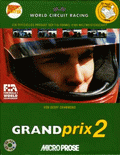
































Grand Prix 2

Grand Prix 2, sometimes known as 'GP2' and sold in the American market as Grand Prix II, is a racing simulator released by MicroProse in 1996. It was made under an official FIA license that featured the Formula One 1994 season, with all of the circuits, teams, drivers and cars. The cars were painted with liveries reflecting the races that did not allow tobacco and beer sponsors (e.g. 1994 British Grand Prix).
It had 3D texture mapping and SVGA graphics, as well as an early but realistic physics engine. A large community of GP2 enthusiasts formed quickly and still exists today. Grand Prix 2 is recognized as one of the definitive racing simulations of its era.
The game is a simulation of the 1994 Formula One season with all 16 circuits from the 1994 season and 28 drivers in their 14 teams. Unlike the real 1994 season, where teams changed drivers repeatedly, the game has a consistent driver list throughout, which is based on British and German Grands Prix. Ayrton Senna and Roland Ratzenberger, who both were killed during the season have been left out of the game, presumably as a mark of respect as well as the aforementioned flexible driver roster for that year. The liveries for each of the cars are also based on their appearance at the 1994 British Grand Prix, where all teams ran non-tobacco livery. It includes all parts of a Formula One weekend, including practice, qualifying and racing. It also included a championship mode which simulated the entire season.
There was no 'arcade' mode in Grand Prix II, per se, but it included the ability to turn on and off such things as indestructibility. There were seven major functions called 'driving aids' that could be turned on or off: steering help, braking help, automatic turn-around (has the car face forward after a crash), indestructibility, racing line help, automatic shifting and traction control. The game had five levels of difficulty one could choose from, and the higher the level, the less options for driving aids one could turn on or off.
There also is a 'Quickrace' function that lets the player jump into a race without having to go through the perfunctory qualifying session. The quickrace option was customizable, allowing a player to race as many laps as desired and allow the player to set their grid position.
The player selects the car they will drive among the 28 seats available, supplanting the driver who originally raced in that vehicle. The game had multiple camera angles, including a simulated TV coverage angle. A player can control his or her car from any of them, but the primary angle used was the first-person cockpit angle. The cars can be customizable in myriad ways through the setup function. Car setups could be modified to high detail with a high degree of accuracy and attention to detail.
Usually people raced as single player. The game also offered multiplayer and modem-linked gaming. A race can be played in turns, with different players driving different cars in the race. Gameplay in this mode has one player at a time driving their car in the race. Instead of a split screen game, The computer simulates the driving for the other players' cars when they are not being controlled by one of the players waiting their turn.
The game also featured a replay function and save game feature. The replay function showed the last ~30 seconds of racing and included the ability to save replays. It did not include an edit function. The save game feature allowed players to save their progress in the game.
The game also replicated engine, gearbox and electronic failures. This meant cars not only could crash, but also have flames or smoke shoot out of the backs of their cars from engine failure, to which they raced around the circuit damaged for a limited time before parking at the side of the road or in the pits. This was the first to simulate visual car failures; as in 1989's Indianapolis 500: The Simulation cars fell out of the race but went to the pits and parked permanently when a car failure was present.
Grand Prix II did not include wet weather conditions. There also was the lack of a 'black flag' system replicating Formula One regulation penalties for course cutting, instead slowing the car down for a limited period of time if the course is cut through.
How to play:
Click on the joystick icon in the Grand Prix 2 online emulator to see how to control the Grand Prix 2 game









































Comments